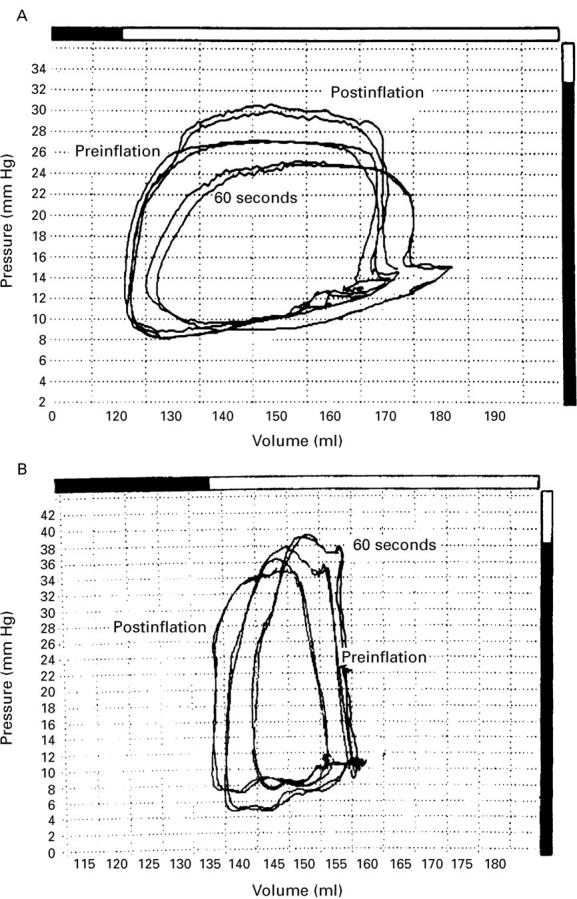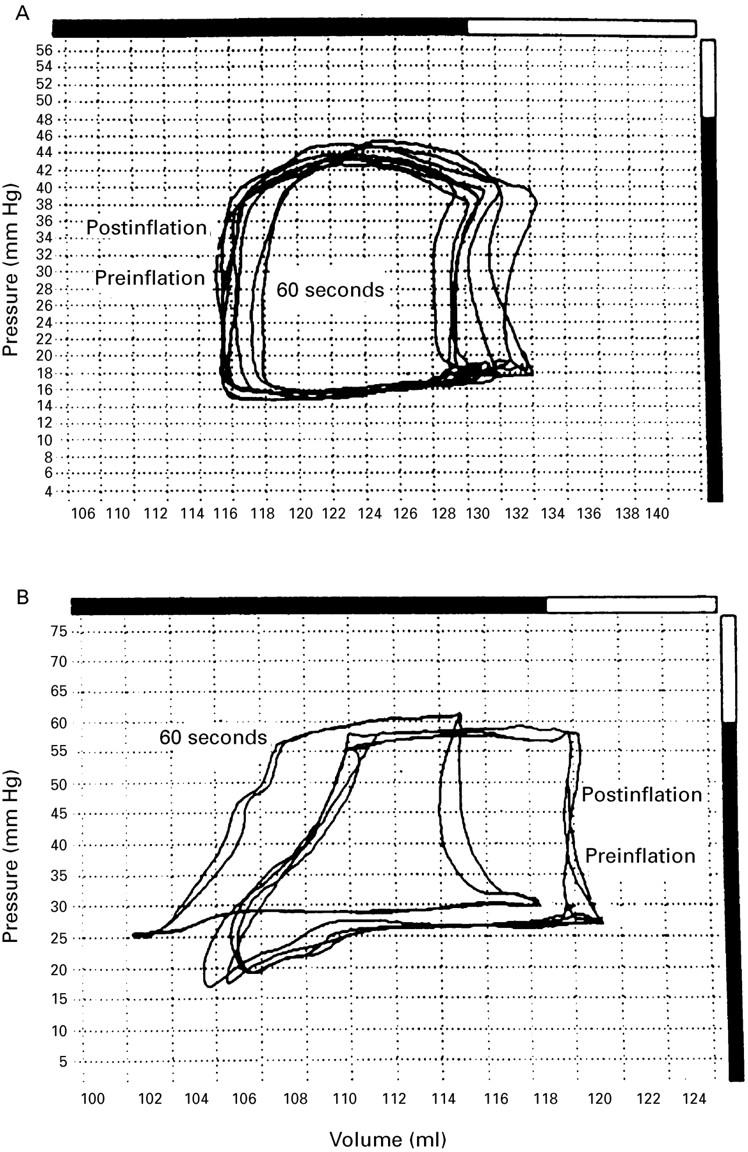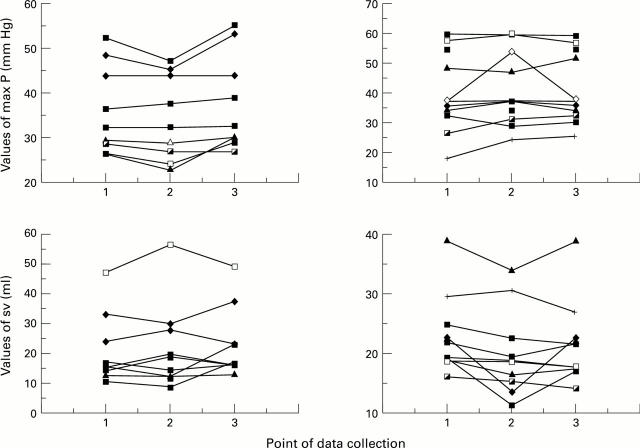Abstract
Objective—To study the effects of coronary artery occlusion on the pressure-volume relations of the right ventricle. Design—Right ventricular pressure-volume cycles were studied using conductance catheters and micromanometers in 19 subjects undergoing coronary angioplasty in a tertiary referral cardiac centre. Results—Catheter occlusions of either the left anterior descending coronary artery or the right coronary artery were associated with a decline in stroke work (mean change (SD): left −13.3(15.8)%, p = 0.008; right −13.5(16.5)%, p = 0.04). Two patterns of change were evident: an upward shift usually associated with occlusion in the left coronary artery, and a rightward shift in the right coronary artery. In the former there was an increase in maximum ventricular volume (mean change: 3.0(2.7)%, p = 0.004) and in minimum ventricular volume (mean change: 2.3(2.7)%, p = 0.01) and a fall in peak pressure (mean change: −4.8(5.1)%, p = 0.04). In the latter there was an increase in peak pressure (mean change 9.9(16.3)%, p = 0.04) and an increase in minimum ventricular volume (mean change 3.7(5.0)%, p = 0.02) leading to a fall in stroke volume (mean change −13.3(15.8)%, p = 0.008). Conclusions—Occlusion of the left anterior descending coronary artery or the right coronary artery is associated with a decline in right ventricular work. However, different patterns of change in indices of preload and afterload lead to different effects on overall right ventricular pump function. Keywords: right ventricle; pressure-volume relations; coronary angioplasty; conductance catheter
Full Text
The Full Text of this article is available as a PDF (203.7 KB).
Figure 1 .
Values of maximum right ventricular pressure (maxP) and conductance derived stroke volume (sv) in subjects undergoing coronary angioplasty. Values are displayed before balloon inflation (1), after 60 seconds of inflation (2), and 60 seconds after balloon deflation (3). Data from right coronary artery inflations are shown on the left and from left anterior descending coronary artery inflations on the right.
Figure 2 .

Right ventricular pressure-volume cycles from patients undergoing coronary angioplasty to lesions in the right coronary artery (above) and left anterior descending coronary artery (below). Two characteristic patterns of shift are contrasted with predominant rightward or vertical displacement. Vertical displacement is associated with a reduction in stroke volume, which in this subject results from a predominant reduction in maximum ventricular volume, while stroke volume during right ward displacement is maintained.
Figure 3 .

Right ventricular pressure-volume cycles from patients undergoing coronary angioplasty to lesions in the right coronary artery (above) and left anterior descending coronary artery (below). Two characteristic patterns of change in the diastolic pressure-volume relations are contrasted. The cycles in the top figure follow a continuous relation, and those in the bottom figure are displaced vertically during coronary artery occlusion.
Selected References
These references are in PubMed. This may not be the complete list of references from this article.
- Applegate R. J. Load dependence of left ventricular diastolic pressure-volume relations during short-term coronary artery occlusion. Circulation. 1991 Feb;83(2):661–673. doi: 10.1161/01.cir.83.2.661. [DOI] [PubMed] [Google Scholar]
- Baker B. J., Wilen M. M., Boyd C. M., Dinh H., Franciosa J. A. Relation of right ventricular ejection fraction to exercise capacity in chronic left ventricular failure. Am J Cardiol. 1984 Sep 1;54(6):596–599. doi: 10.1016/0002-9149(84)90256-x. [DOI] [PubMed] [Google Scholar]
- Berger H. J., Johnstone D. E., Sands J. M., Gottschalk A., Zaret B. L. Response of right ventricular ejection fraction to upright bicycle exercise in coronary artery disease. Circulation. 1979 Dec;60(6):1292–1300. doi: 10.1161/01.cir.60.6.1292. [DOI] [PubMed] [Google Scholar]
- Bertrand M. E., Lablanche J. M., Fourrier J. L., Traisnel G., Mirsky I. Left ventricular systolic and diastolic function during acute coronary artery balloon occlusion in humans. J Am Coll Cardiol. 1988 Aug;12(2):341–347. doi: 10.1016/0735-1097(88)90403-2. [DOI] [PubMed] [Google Scholar]
- Brown K. A., Okada R. D., Boucher C. A., Strauss H. W., Pohost G. M. Right ventricular ejection fraction response to exercise in patients with coronary artery disease: influence of both right coronary artery disease and exercise-induced changes in right ventricular afterload. J Am Coll Cardiol. 1984 Apr;3(4):895–901. doi: 10.1016/s0735-1097(84)80346-0. [DOI] [PubMed] [Google Scholar]
- Burger W., Hansen C., Allroggen H., Kober G. Effects of exercise or temporary coronary occlusion during angioplasty on right ventricular function with consideration of left-anterior-descending- and right-coronary-artery-related myocardial ischemia. Cardiology. 1993;83(5-6):345–357. doi: 10.1159/000175991. [DOI] [PubMed] [Google Scholar]
- Cohn J. N., Guiha N. H., Broder M. I., Limas C. J. Right ventricular infarction. Clinical and hemodynamic features. Am J Cardiol. 1974 Feb;33(2):209–214. doi: 10.1016/0002-9149(74)90276-8. [DOI] [PubMed] [Google Scholar]
- Danchin N., Juilliere Y., Schrijen F., Cherrier F. Differential effects on right ventricular function of transient right, left anterior descending and left circumflex coronary occlusions during percutaneous transluminal coronary angioplasty. J Am Coll Cardiol. 1991 Aug;18(2):437–442. doi: 10.1016/0735-1097(91)90597-3. [DOI] [PubMed] [Google Scholar]
- Danchin N., Juilliere Y., Schrijen F., Cherrier F. Right ventricular function during transient myocardial ischemia induced by percutaneous transluminal angioplasty of the proximal right coronary artery. Am J Cardiol. 1989 Apr 15;63(13):989–991. doi: 10.1016/0002-9149(89)90155-0. [DOI] [PubMed] [Google Scholar]
- Dell'Italia L. J., Walsh R. A. Right ventricular diastolic pressure-volume relations and regional dimensions during acute alterations in loading conditions. Circulation. 1988 Jun;77(6):1276–1282. doi: 10.1161/01.cir.77.6.1276. [DOI] [PubMed] [Google Scholar]
- Dickstein M. L., Yano O., Spotnitz H. M., Burkhoff D. Assessment of right ventricular contractile state with the conductance catheter technique in the pig. Cardiovasc Res. 1995 Jun;29(6):820–826. [PubMed] [Google Scholar]
- Fontan F., Baudet E. Surgical repair of tricuspid atresia. Thorax. 1971 May;26(3):240–248. doi: 10.1136/thx.26.3.240. [DOI] [PMC free article] [PubMed] [Google Scholar]
- Glower D. D., Spratt J. A., Snow N. D., Kabas J. S., Davis J. W., Olsen C. O., Tyson G. S., Sabiston D. C., Jr, Rankin J. S. Linearity of the Frank-Starling relationship in the intact heart: the concept of preload recruitable stroke work. Circulation. 1985 May;71(5):994–1009. doi: 10.1161/01.cir.71.5.994. [DOI] [PubMed] [Google Scholar]
- Karunanithi M. K., Michniewicz J., Copeland S. E., Feneley M. P. Right ventricular preload recruitable stroke work, end-systolic pressure-volume, and dP/dtmax-end-diastolic volume relations compared as indexes of right ventricular contractile performance in conscious dogs. Circ Res. 1992 Jun;70(6):1169–1179. doi: 10.1161/01.res.70.6.1169. [DOI] [PubMed] [Google Scholar]
- Krams R., Soei L. K., McFalls E. O., Winkler Prins E. A., Sassen L. M., Verdouw P. D. End-systolic pressure length relations of stunned right and left ventricles after inotropic stimulation. Am J Physiol. 1993 Dec;265(6 Pt 2):H2099–H2109. doi: 10.1152/ajpheart.1993.265.6.H2099. [DOI] [PubMed] [Google Scholar]
- Kussmaul W. G., Wieland J. M., Laskey W. K. Pressure-flow relations in the pulmonary artery during myocardial ischaemia: implications for right ventricular function in coronary disease. Cardiovasc Res. 1988 Sep;22(9):627–638. doi: 10.1093/cvr/22.9.627. [DOI] [PubMed] [Google Scholar]
- Maughan W. L., Shoukas A. A., Sagawa K., Weisfeldt M. L. Instantaneous pressure-volume relationship of the canine right ventricle. Circ Res. 1979 Mar;44(3):309–315. doi: 10.1161/01.res.44.3.309. [DOI] [PubMed] [Google Scholar]
- Mauser M., Karsch K. R., Seipel L. Effect of right coronary artery occlusion during percutaneous transluminal coronary angioplasty on right ventricular performance. Am J Cardiol. 1988 Mar 1;61(8):648–650. doi: 10.1016/0002-9149(88)90783-7. [DOI] [PubMed] [Google Scholar]
- Polak J. F., Holman B. L., Wynne J., Colucci W. S. Right ventricular ejection fraction: an indicator of increased mortality in patients with congestive heart failure associated with coronary artery disease. J Am Coll Cardiol. 1983 Aug;2(2):217–224. doi: 10.1016/s0735-1097(83)80156-9. [DOI] [PubMed] [Google Scholar]
- Redington A. N., Rigby M. L., Shinebourne E. A., Oldershaw P. J. Changes in the pressure-volume relation of the right ventricle when its loading conditions are modified. Br Heart J. 1990 Jan;63(1):45–49. doi: 10.1136/hrt.63.1.45. [DOI] [PMC free article] [PubMed] [Google Scholar]
- Sade R. M., Castaneda A. R. The dispensable right ventricle. Surgery. 1975 May;77(5):624–631. [PubMed] [Google Scholar]
- Serruys P. W., Wijns W., van den Brand M., Meij S., Slager C., Schuurbiers J. C., Hugenholtz P. G., Brower R. W. Left ventricular performance, regional blood flow, wall motion, and lactate metabolism during transluminal angioplasty. Circulation. 1984 Jul;70(1):25–36. doi: 10.1161/01.cir.70.1.25. [DOI] [PubMed] [Google Scholar]
- Stamato T. M., Szwarc R. S., Benson L. N. Measurement of right ventricular volume by conductance catheter in closed-chest pigs. Am J Physiol. 1995 Sep;269(3 Pt 2):H869–H876. doi: 10.1152/ajpheart.1995.269.3.H869. [DOI] [PubMed] [Google Scholar]
- Vyden J. K., Takano T., Nagasawa K., Ogawa T., Groseth-Robertson M., Swan H. J. Effect of sex difference and pregnancy on the normal reactive hyperemia curve. Am J Physiol. 1977 Oct;233(4):H500–H504. doi: 10.1152/ajpheart.1977.233.4.H500. [DOI] [PubMed] [Google Scholar]
- Weber K. T., Janicki J. S., Shroff S., Fishman A. P. Contractile mechanics and interaction of the right and left ventricles. Am J Cardiol. 1981 Mar;47(3):686–695. doi: 10.1016/0002-9149(81)90556-7. [DOI] [PubMed] [Google Scholar]
- White P. A., Bishop A. J., Conroy B., Oldershaw P. J., Redington A. N. The determination of volume of right ventricular casts using a conductance catheter. Eur Heart J. 1995 Oct;16(10):1425–1429. doi: 10.1093/oxfordjournals.eurheartj.a060751. [DOI] [PubMed] [Google Scholar]
- Zehender M., Kasper W., Kauder E., Schönthaler M., Geibel A., Olschewski M., Just H. Right ventricular infarction as an independent predictor of prognosis after acute inferior myocardial infarction. N Engl J Med. 1993 Apr 8;328(14):981–988. doi: 10.1056/NEJM199304083281401. [DOI] [PubMed] [Google Scholar]



